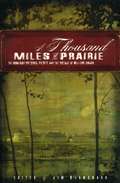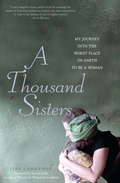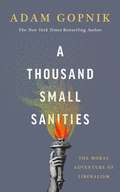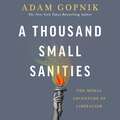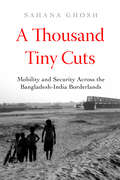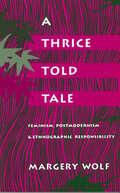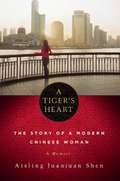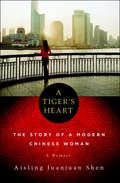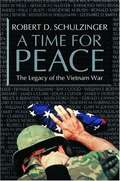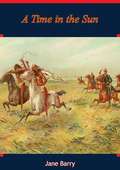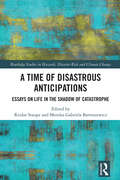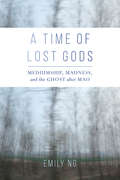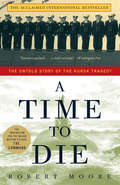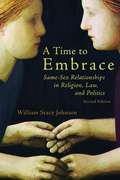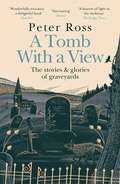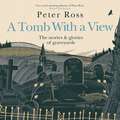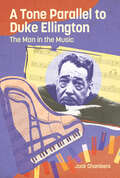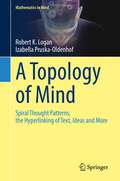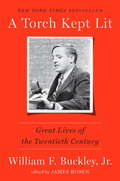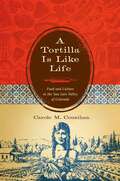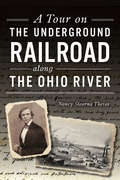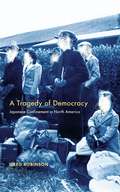- Table View
- List View
A Thousand Miles of Prairie: The Manitoba Historical Society and the History of Western Canada
by Jim BlanchardA Thousand Miles of Prairie is a fascinating look at Manitoba's early boom years (1880-1910) through the eyes and words of some of the most interesting personalities of early Winnipeg. This collection brings together 14 pieces from the first decades of the Manitoba Historical Society, when its lectures were attended by the provinceís political and cultural elite. Jim Blanchard has chosen selections that give us a vivid taste of the diversity of intellectual life in turn of the century Manitoba. Besides writings by early historians such as George Bryce and Charles Bell, he includes a paper by the young Ernest Thompson Seton, who writes about his attempts to raise prairie chickens. There is also a description of the last passenger pigeons found in Manitoba. The collection includes lively personal reminscences, such as Gilbert McMicken, Canada's first spymaster, talking about foiling a Fenian raid on Winnipeg, and Archbishop Samuel Matheson, who tells about his boyhood adventures in the great Red River floods of the 1860s.
A Thousand Shards of Glass
by Michael KatakisA visceral and eviscerating lament for the USA, the country Katakis loved but can no longer bear to live in.Once upon a time, Michael Katakis lived in a place of big dreams, bright colours and sleight of hand. That place was America. One night, travelling where those who live within illusions should never go, he stared into the darkness and glimpsed a faded flag where shadows gathered, revealing another America. It was a broken place, bred from fear and distrust - a thousand shards of glass - filled with a people who long ago had given away all that was precious; a people who had been sold, for so long, a foreign betrayal that finally came from within, and for nothing more than a handful of silver. These essays, letters and journal entries were written as a farewell to the country Michael loves still, and to the wife he knew as his 'True North'. A powerful and personal polemic, A Thousand Shards of Glass is Michael's appeal to his fellow citizens to change their course; a cautionary tale to those around the world who idealise an America that never was; and, crucially, a glimpse beyond the myth, to a country whose best days could still lie ahead.
A Thousand Sisters: My Journey into the Worst Place on Earth to Be a Woman
by Zainab Salbi Lisa J ShannonLisa J. Shannon had a good life--a successful business, a fiancé, a home, and security. Then, one day in 2005, an episode of Oprah changed all that. The show focused on women in Congo, the worst place on earth to be a woman. She was awakened to the atrocities there--millions dead, women raped and tortured daily, and children dying in shocking numbers. Shannon felt called to do something. And she did. A Thousand Sisters is her inspiring memoir. She raised money to sponsor Congolese women, beginning with one solo 30-mile run, and then founded a national organization, Run for Congo Women. The book chronicles her journey to the Congo to meet the women her run sponsored, and shares their incredible stories. What begins as grassroots activism forces Shannon to confront herself and her life, and learn lessons of survival, fear, gratitude, and immense love from the women of Africa.
A Thousand Small Sanities: The Moral Adventure of Liberalism
by Adam Gopnik'WITTY, HUMANE, LEARNED' NEW YORK TIMESThe New York Times-bestselling author offers a stirring defence of liberalism against the dogmatisms of our timeNot since the early twentieth century has liberalism, and liberals, been under such relentless attack, from both right and left. The crisis of democracy in our era has produced a crisis of faith in liberal institutions and, even worse, in liberal thought.A Thousand Small Sanities is a manifesto rooted in the lives of people who invented and extended the liberal tradition. Taking us from Montaigne to Mill, and from Middlemarch to the civil rights movement, Adam Gopnik argues that liberalism is not a form of centrism, nor simply another word for free markets, nor merely a term denoting a set of rights. It is something far more ambitious: the search for radical change by humane measures. Gopnik shows us why liberalism is one of the great moral adventures in human history--and why, in an age of autocracy, our lives may depend on its continuation.
A Thousand Small Sanities: The Moral Adventure of Liberalism
by Adam Gopnik'WITTY, HUMANE, LEARNED' NEW YORK TIMESThe New York Times-bestselling author offers a stirring defence of liberalism against the dogmatisms of our timeNot since the early twentieth century has liberalism, and liberals, been under such relentless attack, from both right and left. The crisis of democracy in our era has produced a crisis of faith in liberal institutions and, even worse, in liberal thought.A Thousand Small Sanities is a manifesto rooted in the lives of people who invented and extended the liberal tradition. Taking us from Montaigne to Mill, and from Middlemarch to the civil rights movement, Adam Gopnik argues that liberalism is not a form of centrism, nor simply another word for free markets, nor merely a term denoting a set of rights. It is something far more ambitious: the search for radical change by humane measures. Gopnik shows us why liberalism is one of the great moral adventures in human history--and why, in an age of autocracy, our lives may depend on its continuation.(P)2019 Hachette Audio
A Thousand Tiny Cuts: Mobility and Security across the Bangladesh-India Borderlands (Atelier: Ethnographic Inquiry in the Twenty-First Century #10)
by Sahana GhoshA Thousand Tiny Cuts chronicles the slow transformation of a connected region into national borderlands. Drawing on a decade of fieldwork in northern Bangladesh and eastern India, Sahana Ghosh shows the foundational place of gender and sexuality in the making and management of threat in relation to mobility. Rather than focusing solely on border fences and border crossings, she demonstrates that bordering reorders relations of value. The cost of militarization across this ostensibly "friendly" border is devaluation—of agrarian land and crops, of borderland youth undesirable as brides and grooms in their respective national hinterlands, of regional infrastructures now disconnected, and of social and physical geographies disordered by surveillance. Through a textured ethnography of the gendered political economy of mobility across postcolonial borderlands in South Asia, this ambitious book challenges anthropological understandings of the violence of bordering, migration and citizenship, and transnational inequalities that are based on Euro-American borders and security regimes.
A Thrice-Told Tale: Feminism, Postmodernism, and Ethnographic Responsibility
by Margery WolfA Thrice-Told Tale is one ethnographer's imaginative and powerful response to the methodological issues raised by feminist and postmodernist critics of traditional ethnography. The author, a feminist anthropologist, uses three texts developed out of her research in Taiwan--a piece of fiction, anthropological fieldnotes, and a social science article--to explore some of these criticisms. Each text takes a different perspective, is written in a different style, and has different "outcomes," yet all three involve the same fascinating set of events. A young mother began to behave in a decidedly abherrant, perhaps suicidal manner, and opinion in her village was sharply divided over the reason. Was she becoming a shaman, posessed by a god? Was she deranged, in need of physical restraint, drugs, and hospitalization? Or was she being cynically manipulated by her ne'er-do-well husband to elicit sympathy and money from her neighbors? In the end, the woman was taken away from the area to her mother's house. For some villagers, this settled the matter; for others the debate over her behavior was probably never truly resolved. The first text is a short story written shortly after the incident, which occurred almost thrity years ago; the second text is a copy of the fieldnotes collected about the events covered in the short story; the third text is an article published in 1990 in American Ethnologist that analyzes the incident from the author's current perspective. Following each text is a Commentary in which the author discusses such topics as experimental ethnography, polyvocality, authorial presence and control, reflexivity, and some of the differences between fiction and ethnography. The three texts are framed by two chapters in which the author discusses the genereal problems posed by feminist and postmodernist critics of ethnography and presents her personal exploration of these issues in an argument that is strongly self-reflexive and theoretically rigorous. She considers some feminist concerns over colonial research methods and takes issues with the insistence of some feminists tha the topics of ethnographic research be set by those who are studied. The book concludes with a plea for ethnographic responsibility based on a less academic and more practical perspective.
A Tiger's Hear
by Aisling Juanjuan ShenBorn to illiterate peasants, Aisling Juanjuan Shen was the first in her village to go to college. Assigned to a low-paying government job, she left for southern China to find success. Her story embodies the changes in China in recent decades.
A Tiger's Heart: The Story of a Modern Chinese Woman
by Aisling Juanjuan ShenThis remarkable true story of a Chinese peasant girl&’s unlikely rise to success is &“like a suspense novel . . . Impossible to put down&”(Library Journal, starred review). Aisling Juanjuan Shen was born to illiterate peasants in a tiny farming hamlet in China&’s Yangtze Delta in 1974. Pronounced useless by her parents because she wasn&’t good at planting rice, she became the first person from her village ever to attend college. After graduating with a teaching degree, the government assigned her to a remote and low-paying job that she was expected to hold for the rest of her life. But she wasn&’t satisfied—and she bought her way out of her secure position and left for the special economic zones of southern China, in search of happiness and success in the business world, eventually immigrating to the United States. In this memoir, Aisling chronicles her rise from rural poverty to a successful career, illustrating the massive economic and social changes that have taken place in China over the past several decades. Her story is emblematic of a new generation of Chinese women who are leaving the rice paddies and government jobs in order to enter the free market and determine the course of their own lives.
A Time for Peace: The Legacy of the Vietnam War
by Robert D. SchulzingerA Time for Peace: The Legacy of the Vietnam War tells the story of how the American War in Vietnam has been remembered and the effects different memories have had on current events. This book is divided into four parts: Part I, "International Affairs", Part II, "Veterans and Vietnamese Americans", Part III, "Cultural Legacies", and Part IV, "Conclusion: Political Echoes of a War".
A Time in the Sun: An Epic Novel Of The Apaches And The Struggle For Arizona
by Jane BarryA major novel of the Indian wars in the far West, told from both points of view—the Apache’s and the white man’s.Anna Stillman was on her way to Tucson to marry Lieutenant Linus Degnan, the son of the commandant of the U.S. fort there, when she was captured by an Apache raiding party. It was 1870, and the Apaches were making a fierce last stand against the white men who were driving them from their land.The Degnans, father and son, soon realized that any attempt to rescue Anna by force would endanger her life, and so they sent Shafter, an ex-Confederate whom the Indians trusted, to try to ransom her. Victorio, leader of the Mimbreños tribe, willingly set a price for the release of the Mexican girl who had been Anna’s traveling companion, but was unwilling to ransom Anna.Greatly disturbed by the Mexican girl’s report that Anna was living with an Apache brave, Linus and his father made every effort to get her back, only to discover that she no longer wanted to be rescued.Jane Barry develops her characters in depth—Anna, who could not avoid hurting the man she had always intended to marry; Joaquin, who had cast his lot with the Apaches when he found that he was not accepted in the white man’s world; Linus, whose struggle to save Anna made a man of him; and Shafter, who tried to be a friend to both Joaquin and Linus.Most of the Apache chiefs and some of the Americans who figure in the book are historical personages. Mrs. Barry’s thorough research has enabled her to bring the Apache civilization to life in vivid detail. A TIME IN THE SUN is a powerful novel about the conflicts experienced by people at odds with one another caught between two ways of life.
A Time of Disastrous Anticipations: Essays on Life in the Shadow of Catastrophe (Routledge Studies in Hazards, Disaster Risk and Climate Change)
by Reidar Staupe Monika Gabriela BartoszewiczThis book explores the pervasive anticipation of catastrophe in contemporary society, examining how temporal expectations shape personal and collective experiences and influence our perspectives and responses.A Time of Disastrous Anticipations highlights the role of anticipation in shaping societal narratives, exploring strategies for redefining responses to catastrophic imaginaries. Through a combination of theoretical insights with practical examples, it offers a comprehensive view of anticipation’s impact in contemporary society. The vista of disastrous anticipations reveals that catastrophe is not so much a matter out of place, but primarily a matter out of time.Targeted at scholars, students, and professionals in sociology, disaster studies, and public policy, this book is also valuable for policymakers and practitioners interested in understanding the societal dimension of disaster anticipation.
A Time of Lost Gods: Mediumship, Madness, and the Ghost after Mao
by Emily NgTraversing visible and invisible realms, A Time of Lost Gods attends to profound rereadings of politics, religion, and madness in the cosmic accounts of spirit mediumship. Drawing on research across a temple, a psychiatric unit, and the home altars of spirit mediums in a rural county of China’s Central Plain, it asks: What ghostly forms emerge after the death of Mao and the so-called end of history? The story of religion in China since the market reforms of the late 1970s is often told through its destruction under Mao and relative flourishing thereafter. Here, those who engage in mediumship offer a different history of the present. They approach Mao’s reign not simply as an earthly secular rule, but an exceptional interval of divine sovereignty, after which the cosmos collapsed into chaos. Caught between a fading era and an ever-receding horizon, those "left behind" by labor outmigration refigure the evacuated hometown as an ethical-spiritual center to come, amidst a proliferation of madness-inducing spirits. Following pronouncements of China’s rise, and in the wake of what Chinese intellectuals termed semicolonialism, the stories here tell of spirit mediums, patients, and psychiatrists caught in a shared dilemma, in a time when gods have lost their way.
A Time to Die: The Kursk Disaster
by Robert MooreAt 10:30am on Saturday August 12, 2000, two massive explosions in a rapid succession shook the icy Arctic waters of the Barents Sea. The Kursk, one of the largest and most technologically advanced nuclear subs in the world, carrying a crew of 118 Russian sailors, had suffered a major, unexplained accident, and rapidly crashed to the ocean floor. Most of us can still remember how news of this terrible accident was reported around the world, and the agonising tension of the days when the doomed crew waited for rescue, the Russians seemed to turn away all international offers to help, until it was too late. Robert Moore, the former Moscow Correspondent of ITN, and now their Foreign Affairs editor, has written a thrilling and authoritative investigative book on this tragedy. He has talked to everyone from the families of the crew, the Russian officials, the international rescue teams and the US submarine crews who were monitoring the Kursk's movements. A TIME TO DIE not only recreates the tragic and terrifying final moments of the submarine and its crew, but also explores the events leading up to it and the political, social and environmental issued raised by the catastrophe. But above all, this is a human story, how the Kursk's crew was doomed, how their surviving families fought to learn the truth about their fate, about the British civilian North Sea divers who tried to assist in the rescue mission; told in a narrative with all the excitement, immediacy and emotional intensity, of bestsellers such as A PERFECT STORM and BLACK HAWK DOWN.
A Time to Embrace: Same-Sex Relationships in Religion, Law, and Politics, 2nd edition
by William Stacy JohnsonIn A Time to Embrace William Stacy Johnson brilliantly analyzes the religious, legal, and political debates about gay marriage, civil unions, and committed gay couples. This new edition includes updates that reflect the many changes in laws pertaining to civil unions / same-sex marriage since 2006.
A Tomb With a View – The Stories & Glories of Graveyards: A Financial Times Book of the Year
by Peter RossA FINANCIAL TIMES, I PAPER AND STYLIST BOOK OF THE YEAR'In his absorbing book about the lost and the gone, Peter Ross takes us from Flanders Fields to Milltown to Kensal Green, to melancholy islands and surprisingly lively ossuaries . . . a considered and moving book on the timely subject of how the dead are remembered, and how they go on working below the surface of our lives.' - Hilary Mantel'Ross is a wonderfully evocative writer, deftly capturing a sense of place and history, while bringing a deep humanity to his subject. He has written a delightful book.' - The Guardian'The pages burst with life and anecdote while also examining our relationship with remembrance.' - Financial Times (best travel books of 2020)'Among the year's most surprising "sleeper" successes is A Tomb with a View. In a year with so much death, it may have initially seemed a hard sell, but the author's humanity has instead acted as a beacon of light in the darkness.' - The Sunday Times'Fascinating . . . Ross makes a likeably idiosyncratic guide and one finishes the book feeling strangely optimistic about the inevitable.' - The Observer'Ross has written [a] lively elegy to Britain's best burial grounds.' - Evening Standard (*Best New Books of Autumn 2020*)'One of the non-fiction books of the year.' - The i paper (*2020 Best Books for Christmas*)'Brilliant.' - Stylist (*Best Christmas books for Christmas 2020*)'Never has a book about death been so full of life. James Joyce and Charles Dickens would've loved it - a book that reveals much gravity in the humour and many stories in the graveyard. It also reveals Peter Ross to be among the best non-fiction writers in the country.' - Andrew O'HaganFor readers of The Salt Path, Mudlarking, Ghostland, Kathleen Jamie and Robert Macfarlane. Enter a grave new world of fascination and delight as award-winning writer Peter Ross uncovers the stories and glories of graveyards. Who are London's outcast dead and why is David Bowie their guardian angel? What is the remarkable truth about Phoebe Hessel, who disguised herself as a man to fight alongside her sweetheart, and went on to live in the reigns of five monarchs? Why is a Bristol cemetery the perfect wedding venue for goths? All of these sorrowful mysteries - and many more - are answered in A Tomb With A View, a book for anyone who has ever wandered through a field of crooked headstones and wondered about the lives and deaths of those who lie beneath.
A Tomb With a View – The Stories & Glories of Graveyards: A Financial Times Book of the Year
by Peter RossA FINANCIAL TIMES, I PAPER AND STYLIST BOOK OF THE YEAR'In his absorbing book about the lost and the gone, Peter Ross takes us from Flanders Fields to Milltown to Kensal Green, to melancholy islands and surprisingly lively ossuaries . . . a considered and moving book on the timely subject of how the dead are remembered, and how they go on working below the surface of our lives.' - Hilary Mantel'Ross is a wonderfully evocative writer, deftly capturing a sense of place and history, while bringing a deep humanity to his subject. He has written a delightful book.' - The Guardian'The pages burst with life and anecdote while also examining our relationship with remembrance.' - Financial Times (best travel books of 2020)'Among the year's most surprising "sleeper" successes is A Tomb with a View. In a year with so much death, it may have initially seemed a hard sell, but the author's humanity has instead acted as a beacon of light in the darkness.' -The Sunday Times'Fascinating . . . Ross makes a likeably idiosyncratic guide and one finishes the book feeling strangely optimistic about the inevitable.' - The Observer'Ross has written [a] lively elegy to Britain's best burial grounds.' - Evening Standard (*Best New Books of Autumn 2020*)'One of the non-fiction books of the year.' - The i paper (*2020 Best Books for Christmas*)'Brilliant.' - Stylist (*Best Christmas books for Christmas 2020*)'Never has a book about death been so full of life. James Joyce and Charles Dickens would've loved it - a book that reveals much gravity in the humour and many stories in the graveyard. It also reveals Peter Ross to be among the best non-fiction writers in the country.' - Andrew O'HaganFor readers of The Salt Path, Mudlarking, Ghostland, Kathleen Jamie and Robert Macfarlane. Enter a grave new world of fascination and delight as award-winning writer Peter Ross uncovers the stories and glories of graveyards. Who are London's outcast dead and why is David Bowie their guardian angel? What is the remarkable truth about Phoebe Hessel, who disguised herself as a man to fight alongside her sweetheart, and went on to live in the reigns of five monarchs? Why is a Bristol cemetery the perfect wedding venue for goths? All of these sorrowful mysteries - and many more - are answered in A Tomb With A View, a book for anyone who has ever wandered through a field of crooked headstones and wondered about the lives and deaths of those who lie beneath.
A Tomb With a View – The Stories & Glories of Graveyards: Scottish Non-fiction Book of the Year 2021
by Peter Ross'In his absorbing book about the lost and the gone, Peter Ross takes us from Flanders Fields to Milltown to Kensal Green, to melancholy islands and surprisingly lively ossuaries . . . a considered and moving book on the timely subject of how the dead are remembered, and how they go on working below the surface of our lives.' - Hilary Mantel'Never has a book about death been so full of life. James Joyce and Charles Dickens would've loved it - a book that reveals much gravity in the humour and many stories in the graveyard. It also reveals Peter Ross to be among the best non-fiction writers in the country.' - Andrew O'Hagan'His stories are always a joy' - Ian Rankin'I'm a card-carrying admirer of Peter Ross' - Robert Macfarlane'A startling, delight-filled tour of graveyards and the people who love them, dazzlingly told.' - Denise Mina'A phenomenal, lyrical, beautiful book.' - Frank TurnerFor readers of The Salt Path, Mudlarking, Ghostland, Kathleen Jamie and Robert Macfarlane.Enter a grave new world of fascination and delight as award-winning writer Peter Ross uncovers the stories and glories of graveyards. Who are London's outcast dead and why is David Bowie their guardian angel? What is the remarkable truth about Phoebe Hessel, who disguised herself as a man to fight alongside her sweetheart, and went on to live in the reigns of five monarchs? Why is a Bristol cemetery the perfect wedding venue for goths?All of these sorrowful mysteries - and many more - are answered in A Tomb With A View, a book for anyone who has ever wandered through a field of crooked headstones and wondered about the lives and deaths of those who lie beneath.So push open the rusting gate, push back the ivy, and take a look inside...(P)2020 Headline Publishing Group Limited
A Tone Parallel to Duke Ellington: The Man in the Music (American Made Music Series)
by Jack ChambersIn this insightful new volume, Jack Chambers explores Edward Kennedy “Duke” Ellington’s music thematically, collating motifs, memes, and predilections that caught Ellington's attention and inspired his restless muse. In presenting Ellington’s work in this manner, Chambers situates the music in the context in which it was created—historical, political, musical, biographic, and personal. Chambers offers a novel kind of access to the man and the music. Ellington’s music presents a daunting task for listeners because of its sheer volume. The numbers defy credulity. Ellington (1899–1974) wrote more than two thousand compositions in numerous genres, including pop songs, big band swing, revues, hymns, tone poems, soundtracks, suites, ballets, concertos, and symphonies. Where to start? The themes in this book offer natural entry points. They provide the context in which the music came into being, with enough biography to satisfy music lovers, even those who come to the book knowing very little about Ellington’s life. Each chapter features its own playlist as a guide to the music discussed, and, in some cases, fuller listings in case readers might want to pursue a topic further. In the early chapters, Chambers covers topics that occupied Ellington through much of his career, and in later chapters he covers more specific themes, some of them from Ellington's last decades, which are less well studied. The music, Ellington said, is his “continuing autobiography,” and it reveals the man behind it.
A Topology of Mind: Spiral Thought Patterns, the Hyperlinking of Text, Ideas and More (Mathematics in Mind)
by Robert K. Logan Izabella Pruska-OldenhofThis volume covers many diverse topics related in varying degrees to mathematics in mind including the mathematical and topological structures of thought and communication. It examines mathematics in mind from the perspective of the spiral, cyclic and hyperlinked structures of the human mind in terms of its language, its thoughts and its various modes of communication in science, philosophy, literature and the arts including a chapter devoted to the spiral structure of the thought of Marshall McLuhan. In it, the authors examine the topological structures of hypertext, hyperlinking, and hypermedia made possible by the Internet and the hyperlinked structures that existed before its emergence. It also explores the cognitive origins of mathematical thinking of the human mind and its relation to the emergence of spoken language, and studies the emergence of mathematical notation and its impact on education. Topics addressed include:• The historical context of any topic that involves how mathematical thinking emerged, focusing on archaeological and philological evidence. • Connection between math cognition and symbolism, annotation and other semiotic processes. • Interrelationships between mathematical discovery and cultural processes, including technological systems that guide the thrust of cognitive and social evolution. • Whether mathematics is an innate faculty or forged in cultural-historical context• What, if any, structures are shared between mathematics and language
A Torch Kept Lit: Great Lives of the Twentieth Century
by William F. Buckley James RosenWilliam F. Buckley, Jr. remembers--as only he could--the towering figures of the twentieth century in a brilliant and emotionally powerful collection, compiled by acclaimed Fox News correspondent James Rosen.In a half century on the national stage, William F. Buckley, Jr. achieved unique stature as a writer, a celebrity, and the undisputed godfather of modern American conservatism. He kept company with the best and brightest, the sultry and powerful. Ronald Reagan pronounced WFB "perhaps the most influential journalist and intellectual in our era," and his jet-setting life was a who's who of high society, fame, and fortune. Among all his distinctions, which include founding the conservative magazine National Review and hosting the long-running talk show Firing Line, Buckley was also a master of that most elusive art form: the eulogy. He drew on his unrivaled gifts to mourn, celebrate, or seek mercy for the men and women who touched his life and the nation. Now, for the first time, WFB's sweeping judgments of the great figures of his time--presidents and prime ministers, celebrities and scoundrels, intellectuals and guitar gods--are collected in one place. A Torch Kept Lit presents more than fifty of Buckley's best eulogies, drawing on his personal memories and private correspondences and using a novelist's touch to conjure his subjects as he knew them. We are reintroduced, through Buckley's eyes, to the likes of Winston Churchill and Ronald Reagan, Elvis Presley and John Lennon, Truman Capote and Martin Luther King, Jr.Curated by Fox News chief Washington correspondent James Rosen, a Buckley protégé and frequent contributor to National Review, this volumes heds light on a tumultuous period in American history--from World War II to Watergate, the "death" of God to the Grateful Dead--as told in the inimitable voice of one of our most elegant literary stylists.William F. Buckley, Jr. is back--just when we need him most.From the Hardcover edition.
A Tortilla Is Like Life: Food and Culture in the San Luis Valley of Colorado (Louann Atkins Temple Women & Culture Series)
by Carole M. CounihanAn innovative portrait of a small Colorado town based on a decade&’s worth of food-centered life histories from nineteen of its female residents.Located in the southern San Luis Valley of Colorado, the remote and relatively unknown town of Antonito is home to an overwhelmingly Hispanic population struggling not only to exist in an economically depressed and politically marginalized area, but also to preserve their culture and their lifeways. Between 1996 and 2006, anthropologist Carole Counihan collected food-centered life histories from nineteen Mexicanas―Hispanic American women―who had long-standing roots in the Upper Rio Grande region. The interviews in this groundbreaking study focused on southern Colorado Hispanic foodways―beliefs and behaviors surrounding food production, distribution, preparation, and consumption.In this book, Counihan features extensive excerpts from these interviews to give voice to the women of Antonito and highlight their perspectives. Three lines of inquiry are framed: feminist ethnography, Latino cultural citizenship, and Chicano environmentalism. Counihan documents how Antonito&’s Mexicanas establish a sense of place and belonging through their knowledge of land and water and use this knowledge to sustain their families and communities. Women play an important role by gardening, canning, and drying vegetables; earning money to buy food; cooking; and feeding family, friends, and neighbors on ordinary and festive occasions. They use food to solder or break relationships and to express contrasting feelings of harmony and generosity, or enmity and envy. The interviews in this book reveal that these Mexicanas are resourceful providers whose food work contributes to cultural survival.&“An important contribution to Mexican American culture.&” ―Oral History Review&“Counihan&’s book is well written and will appeal to a wide spectrum of readers . . . I would recommend this book to those whose interests lie in foodways, gender studies, ethnography and folklore. A Tortilla is Like Life would be a good addition to any reading list, and a beneficial resource for those who desire to understand the complex associations of gender, food, culture and ethnicity.&” —Digest: A Journal of Foodways and Culture
A Tortilla Is Like Life: Food and Culture in the San Luis Valley of Colorado (Louann Atkins Temple Women & Culture Series)
by Carole M. CounihanAn innovative portrait of a small Colorado town based on a decade&’s worth of food-centered life histories from nineteen of its female residents.Located in the southern San Luis Valley of Colorado, the remote and relatively unknown town of Antonito is home to an overwhelmingly Hispanic population struggling not only to exist in an economically depressed and politically marginalized area, but also to preserve their culture and their lifeways. Between 1996 and 2006, anthropologist Carole Counihan collected food-centered life histories from nineteen Mexicanas―Hispanic American women―who had long-standing roots in the Upper Rio Grande region. The interviews in this groundbreaking study focused on southern Colorado Hispanic foodways―beliefs and behaviors surrounding food production, distribution, preparation, and consumption.In this book, Counihan features extensive excerpts from these interviews to give voice to the women of Antonito and highlight their perspectives. Three lines of inquiry are framed: feminist ethnography, Latino cultural citizenship, and Chicano environmentalism. Counihan documents how Antonito&’s Mexicanas establish a sense of place and belonging through their knowledge of land and water and use this knowledge to sustain their families and communities. Women play an important role by gardening, canning, and drying vegetables; earning money to buy food; cooking; and feeding family, friends, and neighbors on ordinary and festive occasions. They use food to solder or break relationships and to express contrasting feelings of harmony and generosity, or enmity and envy. The interviews in this book reveal that these Mexicanas are resourceful providers whose food work contributes to cultural survival.&“An important contribution to Mexican American culture.&” ―Oral History Review&“Counihan&’s book is well written and will appeal to a wide spectrum of readers . . . I would recommend this book to those whose interests lie in foodways, gender studies, ethnography and folklore. A Tortilla is Like Life would be a good addition to any reading list, and a beneficial resource for those who desire to understand the complex associations of gender, food, culture and ethnicity.&” —Digest: A Journal of Foodways and Culture
A Tour on the Underground Railroad along the Ohio River (History & Guide)
by Nancy Stearns TheissRunning for 664 miles along Kentucky's border, the Ohio River provided a remarkable opportunity for the enslaved to escape to free soil in Indiana and Ohio. The river beckoned fugitive slave Henry Bibb onto a steamboat at Madison, Indiana, headed to Cincinnati, where he discovered the Underground Railroad. Upriver from Cincinnati, a lantern signal high on a hill from the Rankin House in Ripley, Ohio, stirred others to flee for freedom. These stories and more along the borderland of the Ohio River also served as the setting for Harriet Beecher Stowe's novel Uncle Tom's Cabin, which became an inspiration of human resistance. Author Nancy Theiss, PhD, takes readers on a tour through American history to places of courage and sacrifice.
A Tragedy of Democracy: Japanese Confinement in North America
by Greg RobinsonThe confinement of some 120,000 Japanese Americans during World War II, often called the Japanese American internment, has been described as the worst official civil rights violation of modern U. S. history. Greg Robinson not only offers a bold new understanding of these events but also studies them within a larger time frame and from a transnational perspective. Drawing on newly discovered material, Robinson provides a backstory of confinement that reveals for the first time the extent of the American government's surveillance of Japanese communities in the years leading up to war and the construction of what officials termed "concentration camps" for enemy aliens. He also considers the aftermath of confinement, including the place of Japanese Americans in postwar civil rights struggles, the long movement by former camp inmates for redress, and the continuing role of the camps as touchstones for nationwide commemoration and debate. Most remarkably, A Tragedy of Democracy is the first book to analyze official policy toward West Coast Japanese Americans within a North American context. Robinson studies confinement on the mainland alongside events in wartime Hawaii, where fears of Japanese Americans justified Army dictatorship, suspension of the Constitution, and the imposition of military tribunals. He similarly reads the treatment of Japanese Americans against Canada's confinement of 22,000 citizens and residents of Japanese ancestry from British Columbia. A Tragedy of Democracy recounts the expulsion of almost 5,000 Japanese from Mexico's Pacific Coast and the poignant story of the Japanese Latin Americans who were kidnapped from their homes and interned in the United States. Approaching Japanese confinement as a continental and international phenomenon, Robinson offers a truly kaleidoscopic understanding of its genesis and outcomes. The confinement of some 120,000 Japanese Americans during World War II, often called the Japanese American internment, has been described as the worst official civil rights violation of modern U. S. history. Greg Robinson not only offers a bold new understanding of these events but also studies them within a larger time frame and from a transnational perspective. Drawing on newly discovered material, Robinson provides a backstory of confinement that reveals for the first time the extent of the American government's surveillance of Japanese communities in the years leading up to war and the construction of what officials termed "concentration camps" for enemy aliens. He also considers the aftermath of confinement, including the place of Japanese Americans in postwar civil rights struggles, the long movement by former camp inmates for redress, and the continuing role of the camps as touchstones for nationwide commemoration and debate. Most remarkably, A Tragedy of Democracy is the first book to analyze official policy toward West Coast Japanese Americans within a North American context. Robinson studies confinement on the mainland alongside events in wartime Hawaii, where fears of Japanese Americans justified Army dictatorship, suspension of the Constitution, and the imposition of military tribunals. He similarly reads the treatment of Japanese Americans against Canada's confinement of 22,000 citizens and residents of Japanese ancestry from British Columbia. A Tragedy of Democracy recounts the expulsion of almost 5,000 Japanese from Mexico's Pacific Coast and the poignant story of the Japanese Latin Americans who were kidnapped from their homes and interned in the United States. Approaching Japanese confinement as a continental and international phenomenon, Robinson offers a truly kaleidoscopic understanding of its genesis and outcomes.
